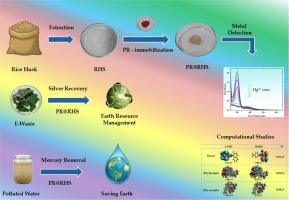Azo-based-functionalized rice husk silica nanocomposites for dual-mode sensing of Hg(II) and Ag(I): Experimental insights and DFT-elucidated mechanism
IF 4.7
2区 化学
Q2 CHEMISTRY, PHYSICAL
引用次数: 0
Abstract
A cost-effective dual-mode sensor was fabricated by covalently immobilizing para red 1-((4-nitrophenyl)diazenyl)naphthalen-2-ol on rice-husk-derived mesoporous silica to yield PR@RHS, a nanocomposite that couples agricultural-waste valorization with high-performance metal-ion detection. Thorough physicochemical characterization confirmed retention of the amorphous silica framework (broad XRD halo at 2θ≈21.35°) and preservation of well-defined mesoporosity (BET surface area 285 m2/g), while FTIR analysis revealed the emergence of C = N and N = N stretching bands, evidencing successful azo-based grafting. Density Functional Theory calculations clarified that Hg(II) coordinates through bidentate ON-chelation, inducing a bathochromic shift, whereas Ag(I) binds linearly to the azo nitrogens, producing a hypsochromic shift and distinct spectral fingerprints. Under optimized conditions (20 mg material in 10 mL solution, pH 4.0 for Hg(II) and pH 3.5 for Ag(I), 25 °C), PR@RHS achieved limits of detection of 13.67 ± 0.45 ppb (RSD = 3.3 %) ppb for Hg(II) and 10.25 ppb ± 0.38 ppb (RSD = 3.1 %) for Ag(I) with rapid response times of 140 s and 90 s, respectively, and negligible interference from 13 common metal ions even at 100 ppm. The probe retained ≥80 % of its initial signal after five EDTA/thiourea regeneration cycles and ≥81 % activity after 12-month room-temperature storage, highlighting outstanding durability. Practical utility was demonstrated by quantitative mercury screening in commercial skin-lightening creams (recoveries 95.8–101.2 %, RSD ≤ 3.8 %) and high-efficiency silver recovery from electronic-waste leachates (overall yield 93.85 % for e-waste). These results establish PR@RHS as a sustainable, reusable platform that bridges environmental monitoring and resource reclamation through green nanotechnology.

偶氮基功能化稻壳二氧化硅纳米复合材料对汞(II)和银(I)的双模传感:实验见解和dft解析机制
通过将对1-((4-硝基苯基)二氮基)萘-2-醇共价固定在稻壳衍生的介孔二氧化硅上,制备了一种具有成本效益的双模传感器PR@RHS,该纳米复合材料将农业废弃物的估值与高性能的金属离子检测结合起来。深入的物理化学表征证实了无定形二氧化硅骨架的保留(2θ≈21.35°的宽XRD晕)和良好介孔的保留(BET表面积285 m2/g),而FTIR分析显示出现了C = N和N = N拉伸带,证明偶氮基接枝成功。密度泛函理论计算表明,Hg(II)通过双齿on螯合进行配位,引起深色偏移,而Ag(I)与偶氮线性结合,产生深色偏移和明显的光谱指纹图谱。在优化条件下(20 mg材料在10 mL溶液中,Hg(II) pH为4.0,Ag(I) pH为3.5,25°C), PR@RHS对Hg(II)和Ag(I)的检出限分别为13.67±0.45 ppb (RSD = 3.3%)和10.25 ppb±0.38 ppb (RSD = 3.1%),快速响应时间分别为140 s和90 s,即使在100 ppm下,13种常见金属离子的干扰也可以忽略。经过5次EDTA/硫脲再生循环后,探针保留了≥80%的初始信号,室温储存12个月后活性≥81%,突出了出色的耐久性。商业美白面霜中汞的定量筛选(回收率95.8 - 101.2%,RSD≤3.8%)和电子垃圾渗滤液中银的高效回收(电子垃圾的总回收率93.85%)证明了其实用性。这些结果使PR@RHS成为一个可持续的、可重复使用的平台,通过绿色纳米技术将环境监测和资源回收联系起来。
本文章由计算机程序翻译,如有差异,请以英文原文为准。
求助全文
约1分钟内获得全文
求助全文
来源期刊

Journal of Molecular Structure
化学-物理化学
CiteScore
7.10
自引率
15.80%
发文量
2384
审稿时长
45 days
期刊介绍:
The Journal of Molecular Structure is dedicated to the publication of full-length articles and review papers, providing important new structural information on all types of chemical species including:
• Stable and unstable molecules in all types of environments (vapour, molecular beam, liquid, solution, liquid crystal, solid state, matrix-isolated, surface-absorbed etc.)
• Chemical intermediates
• Molecules in excited states
• Biological molecules
• Polymers.
The methods used may include any combination of spectroscopic and non-spectroscopic techniques, for example:
• Infrared spectroscopy (mid, far, near)
• Raman spectroscopy and non-linear Raman methods (CARS, etc.)
• Electronic absorption spectroscopy
• Optical rotatory dispersion and circular dichroism
• Fluorescence and phosphorescence techniques
• Electron spectroscopies (PES, XPS), EXAFS, etc.
• Microwave spectroscopy
• Electron diffraction
• NMR and ESR spectroscopies
• Mössbauer spectroscopy
• X-ray crystallography
• Charge Density Analyses
• Computational Studies (supplementing experimental methods)
We encourage publications combining theoretical and experimental approaches. The structural insights gained by the studies should be correlated with the properties, activity and/ or reactivity of the molecule under investigation and the relevance of this molecule and its implications should be discussed.
 求助内容:
求助内容: 应助结果提醒方式:
应助结果提醒方式:


